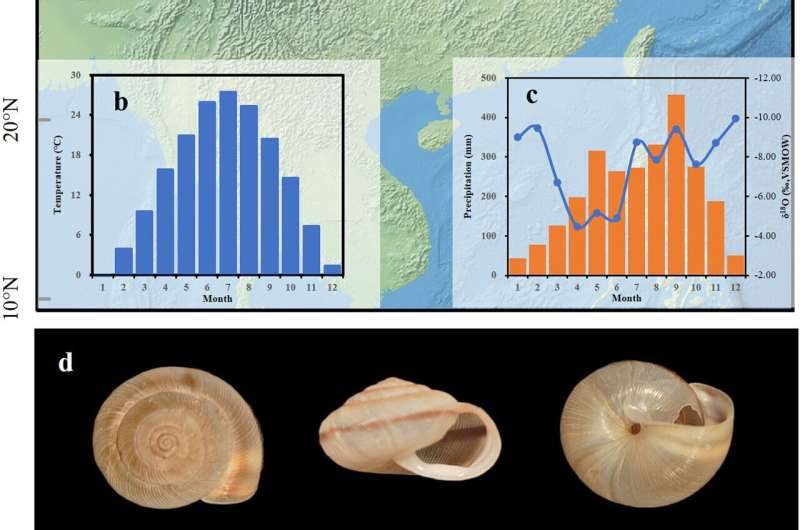Recorders of climate and weather changes
In a study published in Geophysical Research Letters on March 13, researchers from the Institute of Earth Environment of the Chinese Academy of Sciences and Northwest University showed that land snails are very sensitive to climate and environmental changes, and they can record high-resolution terrestrial climate changes.
The researchers performed high-resolution (~0.3 mm intervals) oxygen isotope (δ18Os) analyses of individual snail shells and obtained a large amount of data. They found that the intra-shell δ18Os sequences of land snails were well reproducible and they could reflect seasonal to even daily scale changes of the precipitation δ18O, mainly from March to October in the studied region.
It is worth noting that the calculated average growth rate for non-adult Cathaica fasciola snail shells is as high as ~290 mm/day (varying from 250 to 330 mm/day) according to these new results. This means that the time resolution of each intra-shell sample could reach two to four days using the current manual sampling method.
Thus, the land snail shells are very promising records for reconstructing high-resolution terrestrial environmental changes in the future.
“From the fossil snail shells, we can get climate and weather timescale climatic changes from past warm periods, such as the middle Holocene and the last interglacial. And this can serve as a mirror for us to understand what we may experience in the near future under global warming conditions,” said Dr. Dong Jibao, corresponding author of the study.
This new advance will allow for the integration of studies of ancient and modern climate change.
More information:
Qianya Li et al, High‐Resolution Intrashell Oxygen Isotope Studies of Cathaica fasciola and Bradybaena ravida Land Snails and Their Environmental Implications, Geophysical Research Letters (2024). DOI: 10.1029/2023GL107835
Citation:
Land snails: Recorders of climate and weather changes (2024, March 21)
retrieved 21 March 2024
from https://phys.org/news/2024-03-snails-climate-weather.html
This document is subject to copyright. Apart from any fair dealing for the purpose of private study or research, no
part may be reproduced without the written permission. The content is provided for information purposes only.

In a study published in Geophysical Research Letters on March 13, researchers from the Institute of Earth Environment of the Chinese Academy of Sciences and Northwest University showed that land snails are very sensitive to climate and environmental changes, and they can record high-resolution terrestrial climate changes.
The researchers performed high-resolution (~0.3 mm intervals) oxygen isotope (δ18Os) analyses of individual snail shells and obtained a large amount of data. They found that the intra-shell δ18Os sequences of land snails were well reproducible and they could reflect seasonal to even daily scale changes of the precipitation δ18O, mainly from March to October in the studied region.
It is worth noting that the calculated average growth rate for non-adult Cathaica fasciola snail shells is as high as ~290 mm/day (varying from 250 to 330 mm/day) according to these new results. This means that the time resolution of each intra-shell sample could reach two to four days using the current manual sampling method.
Thus, the land snail shells are very promising records for reconstructing high-resolution terrestrial environmental changes in the future.
“From the fossil snail shells, we can get climate and weather timescale climatic changes from past warm periods, such as the middle Holocene and the last interglacial. And this can serve as a mirror for us to understand what we may experience in the near future under global warming conditions,” said Dr. Dong Jibao, corresponding author of the study.
This new advance will allow for the integration of studies of ancient and modern climate change.
More information:
Qianya Li et al, High‐Resolution Intrashell Oxygen Isotope Studies of Cathaica fasciola and Bradybaena ravida Land Snails and Their Environmental Implications, Geophysical Research Letters (2024). DOI: 10.1029/2023GL107835
Citation:
Land snails: Recorders of climate and weather changes (2024, March 21)
retrieved 21 March 2024
from https://phys.org/news/2024-03-snails-climate-weather.html
This document is subject to copyright. Apart from any fair dealing for the purpose of private study or research, no
part may be reproduced without the written permission. The content is provided for information purposes only.
